Encoding array of unsigned integers
| Author: | Wojciech Muła |
|---|---|
| Added on: | 2013-11-23 |
| Update: | 2013-11-24 (minor updates), 2013-12-01 (pair encoding) |
Introduction
Russ Cox wrote very interesting article about algorithms behind service Google Code Search. In short: files are indexed with trigrams, the query string is split to trigrams and then an index is used to limit number of searched files.
Code search manages a reverse index — there is a file list, and for each trigram there is a list of file's id. I've interested how the list of file's id is stored on a disc. In the Russ implementation such list is built as follows:
- ids are sorted in ascending order;
- differences between current and previous id are encoded using variable length integers (varint).
The variable length integer is a byte-oriented encoding, similar to UTF-8, where each byte holds 7 bit of data and 1 bit (MSB) is used as the end-of-word marker. Thus smaller values require less bytes: integers less than 128 occupy 1 byte, less than 16384 occupy 2 bytes, and so on.
Important: lists of file's id are encoded independently, because of that it is not possible to use any common attributes to increase compression.
Better compression
Encoding subsets of close values
Downside of byte-oriented encoding is wasting bits if values are small. For example list of id:
[10000, 10001, 10003, 10004, 10006, 10007, 10009, 10010, 10017, 11500]
after calculating differences becomes:
[10000, 1, 2, 1, 2, 1, 2, 1, 7, 1488]
The first and the last value could be saved on 2 bytes, rest on 1 byte — total 12 bytes. Small values are stored on one byte, but in fact require 1, 2 or 3 bits, so 5-7 bits in a byte are unused.
It's possible to efficient encode such subset of small values on a bitset of constant size. Difference between each value and the first value ("head") are encoded as bit positions. For subset:
[10000, 10001, 10003, 10004, 10006, 10007, 10009, 10010, 10017]
we have:
- head: 10000 (encoded separately),
- differences set: [1, 3, 4, 6, 7, 9, 10, 17],
- and differences encoded as 32-bit bitset 00000000000000010000001101101101.
Instead of 12 bytes we got 2 + 4 + 2 = 8. Of course for longer subsets results are better, in the best case we can encode one value using just one bit; however, for subsets smaller than 6 elements this operation has no sense.
Note: There is an encoding scheme called Simple9 (see the first position in bibliography) that can achieve similar compression ratio, but Simple9 requires a 4-bit header per 28-bit data word, thus compression ratio in the same scenario would be smaller.
Subset selection algorithm
I've checked two methods:
- greedy — find longest subset in the values, then remove it, repeat until no more subsets could be found;
- first match — sequence scan on sequence elements, get the longest subset starting from the current value.
Although first match seems to be "too easy", this method gives better compression ratio than greedy. Moreover is very fast and simple to implement. Greedy is very, very slow — well maybe some kind of dynamic programming would help, but this wasn't the main subject of research, so I left it "as is".
All results presented here use first match searching.
Varnibble
Varnibble encoding is similar to varint, in this case we operate on 4-bit words instead of 8 bits — each word contains 3 bits of data and 1 bit of end-value marker. This encoding require some bit operations (shift, and, or) but with constant shifts amounts/masks, so this isn't as expansive as other bit-level encoding schemes.
Varnibble decreases mentioned earlier "bit-wasting" for small values.
Varbits
This is generalization of varint and varnibble — the number of data bits can be arbitrary. Selecting the number of bits is done once for the whole sequence, this number is saved on one byte, then all elements are encoded.
Pair encoding
There is compression method called "byte pair encoding", in pair encoding 'values' are used instead of bytes. Algorithm:
- Find the pair of symbols occur most frequently in a sequence
- If there is no such pair — exit
- Assign new value to that pair
- Replace all occurrences of the pair with the new value
- Goto 1
Experiments
Sample data
A set of trigrams and associated file's id were collected from subtree of Linux source. Each list was saved in a separate file, then I picked some of them. Here are some statistics about lists:
- lists count: 853
- min length: 5
- max length: 13002
- avg length: 711
The plot shows size of lists encoded as differences with varint. Most of them are quite short, only few are long.
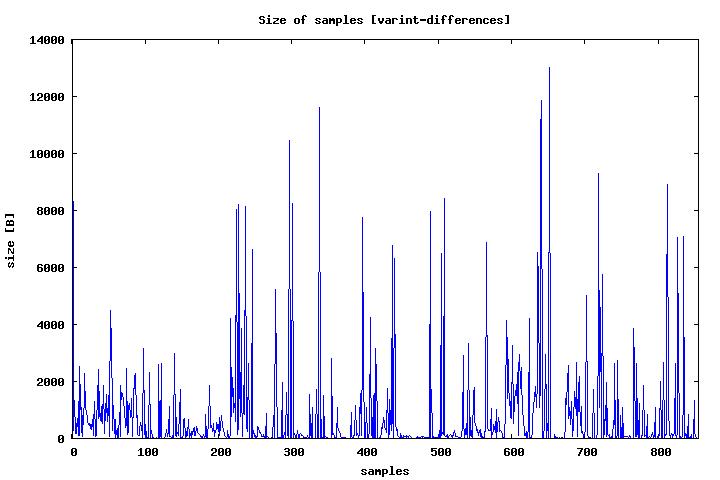
The total size of all lists:
- values encoded using varint: 1,208,400 B
- differences encoded using varint: 621,208 B
It's clear that using differences can save up to 50% of space, so other methods always use differences instead of plain values. Results for differences encoded with varint (called for short varint diff) are set as reference.
Comparisons with other methods are done for following properties:
- total size of all encoded lists;
- how many encoded lists have size greater/less/equal;
- relative space save, calculated as: (encoded size - varint diff size) / varint diff size.
Method 1 — Variable length bitfields
This algorithm finds the minimum number of bits required to save the largest value from single list. Then each value is saved on a bitfield of the calculated width.
Algorithm:
- get the maximum value of differences (except first one)
- calculate number of bits (k) required to save max: ceil(log2max(values));
- save the first value as a 4-byte word;
- save k on 1 byte;
- save differences on k-bits fields.
| count | count [%] | size [B] | size [%] | ||
|---|---|---|---|---|---|
| greater | 369 | 43.26 | 121,264 | 21.61 | 25.04 |
| equal | 49 | 5.74 | 19,240 | 3.43 | |
| less | 435 | 51.00 | 420,537 | 74.96 | |
| total size | 561,041 | ||||
| improvement | 90.31% | ||||
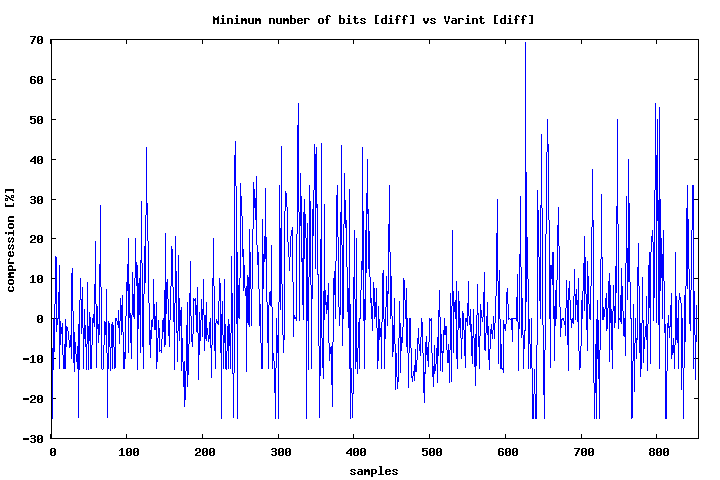
Method 2 — Varnibble
| count | count [%] | size [B] | size [%] | ||
|---|---|---|---|---|---|
| greater | 48 | 5.63 | 766 | 0.20 | 0.52 |
| equal | 82 | 9.61 | 1,234 | 0.32 | |
| less | 723 | 84.76 | 385,867 | 99.48 | |
| total size | 387,867 | ||||
| improvement | 62.44% | ||||
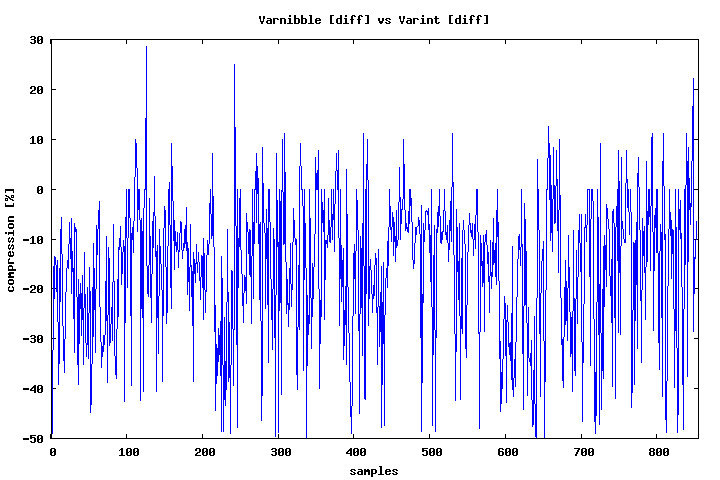
Method 3 — Subsets of close values
Encoding is done in two steps:
- Split values to list of pairs (head, differences subset); a difference subset could be empty if a subset contains less elements then cutoff value; in experiments it was 6 elements. Size of such subset would be greater than encoded values.
- Head values are treated as a separated sequence (again: differences of values are considered) and encoded using varint or varnibble. Encoded values are multiplied by 2 and the lowest bit is set when subset is not empty.
| count | count [%] | size [B] | size [%] | ||
|---|---|---|---|---|---|
| greater | 461 | 54.04 | 66,427 | 17.78 | 18.68 |
| equal | 101 | 11.84 | 3,329 | 0.89 | |
| less | 291 | 34.11 | 303,752 | 81.32 | |
| total size | 373,508 | ||||
| improvement | 60.13% | ||||
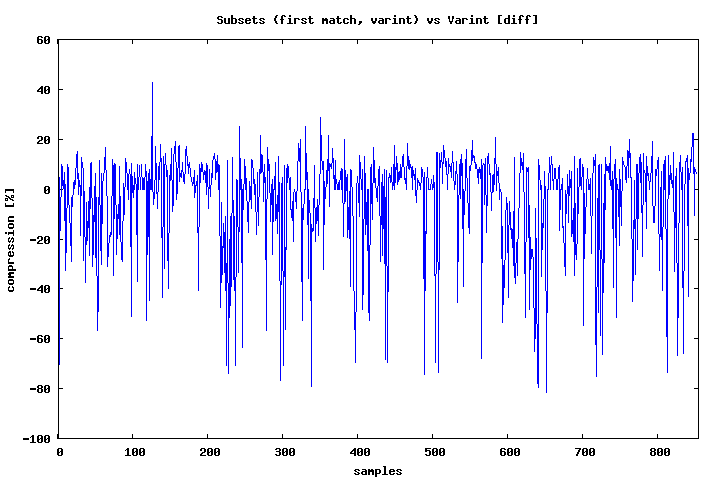
| count | count [%] | size [B] | size [%] | ||
|---|---|---|---|---|---|
| greater | 372 | 43.61 | 34,494 | 9.43 | 10.34 |
| equal | 62 | 7.27 | 3,322 | 0.91 | |
| less | 419 | 49.12 | 327,922 | 89.66 | |
| total size | 365,738 | ||||
| improvement | 58.88% | ||||
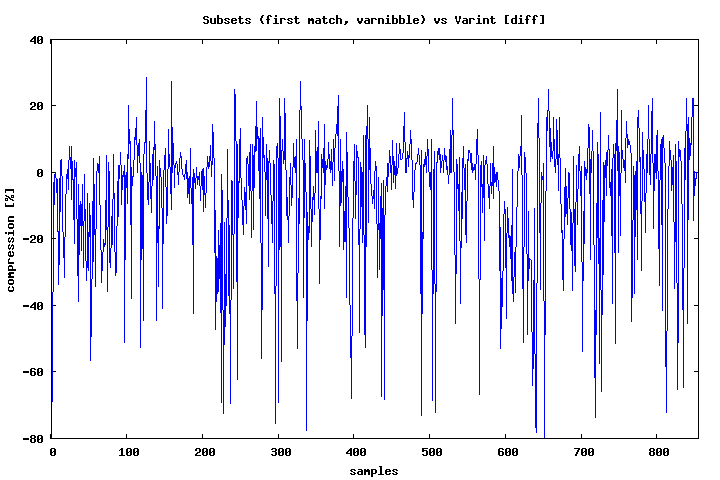
Varnibble is a bit better than varint backend, however the number of samples greater/equal is significant in both cases.
Method 4 — Pick better: subsets of close values or varint/varnibble
As we saw subsets methods are not always better, so there is a room for some improvement. This method is combination of two encodings: method 3 with varint or varnibble encoding.
List of integers is encoded using subsets method and also with varint/varnibble, then shorter form is saved.
We need to save which method is used, this require just one bit — the first element of list is multiplied by 2 and the lowest bit is set/unset depending of the selected method. This solution is cheap, because in the worst case costs an additional byte/nibble, while in average case increase compression ratio.
| count | count [%] | size [B] | size [%] | ||
|---|---|---|---|---|---|
| greater | 0 | 0.00 | 0 | 0.00 | 17.63 |
| equal | 562 | 65.89 | 65,026 | 17.63 | |
| less | 291 | 34.11 | 303,752 | 82.37 | |
| total size | 368,778 | ||||
| improvement | 59.36% | ||||

| count | count [%] | size [B] | size [%] | ||
|---|---|---|---|---|---|
| greater | 48 | 5.63 | 766 | 0.23 | 0.59 |
| equal | 82 | 9.61 | 1,234 | 0.37 | |
| less | 723 | 84.76 | 335,743 | 99.41 | |
| total size | 337,743 | ||||
| improvement | 54.37% | ||||

Method 5 — Varbits
Selecting number of data bits is done in straightforward way: encode data on bits 1..16, then the best one is picked:
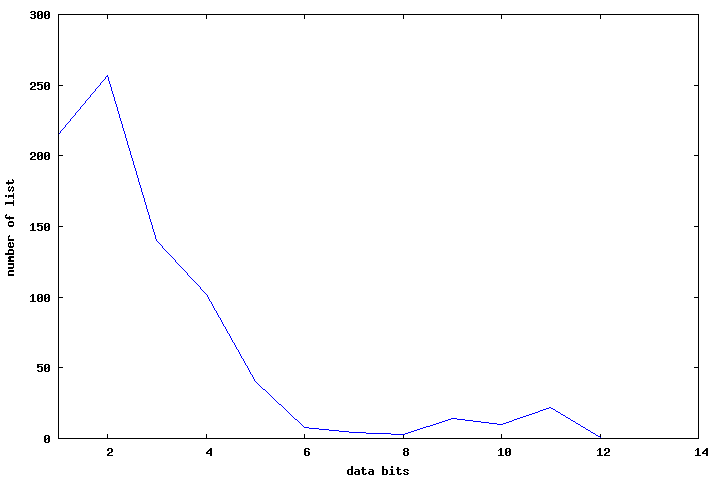
For sample set of data, optimal number of bits is usually smaller than 7 bits used by varint.
| count | count [%] | size [B] | size [%] | ||
|---|---|---|---|---|---|
| greater | 57 | 6.68 | 780 | 0.23 | 0.53 |
| equal | 71 | 8.32 | 1,032 | 0.30 | |
| less | 725 | 84.99 | 339,788 | 99.47 | |
| total size | 341,600 | ||||
| compression | 54.99% | ||||
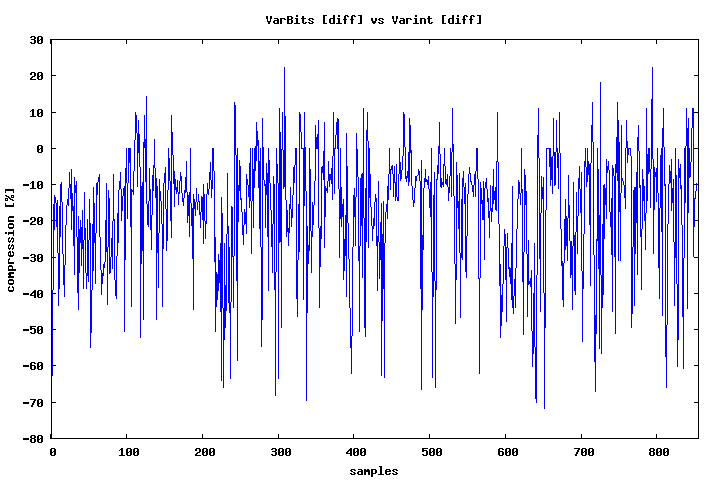
Method 6 — Pair encoding
New values for pair numbers are selected starting from 1, excluding already used values that present in a sequence. Each pair is saved as three values: (pair number, value 1, value 2). The end of a pair list is marked with value 0, then values from sequence are stored. Finally to save values varint and varnibble encoders were used.
Results for varint:
| count | count [%] | size [B] | size [%] | ||
|---|---|---|---|---|---|
| greater | 652 | 76.44 | 131,606 | 29.65 | 29.83 |
| equal | 4 | 0.47 | 806 | 0.18 | |
| less | 197 | 23.09 | 311,480 | 70.17 | |
| total size | 443,892 | ||||
| compression | 71.46% | ||||
Results for varnibble:
| count | count [%] | size [B] | size [%] | ||
|---|---|---|---|---|---|
| greater | 167 | 19.58 | 30,823 | 7.36 | 8.43 |
| equal | 61 | 7.15 | 4,471 | 1.07 | |
| less | 625 | 73.27 | 383,365 | 91.57 | |
| total size | 418,659 | ||||
| compression | 67.39% | ||||
Summary and discussion
| # | method | size | improvement | ||
|---|---|---|---|---|---|
| a | 0 | varint - reference | 621,208 | 100.00% | =================================== |
| b | 1 | bitfields | 561,041 | 90.31% | =============================== |
| c | 2 | varnibble | 387,867 | 62.44% | ===================== |
| d | 3 | subsets [varnibble] | 365,738 | 58.88% | ==================== |
| e | 3 | subsets [varint] | 373,508 | 60.13% | ===================== |
| f | 4 | subsets or varnibble | 337,743 | 54.37% | =================== |
| g | 4 | subsets or varint | 368,778 | 59.36% | ==================== |
| h | 5 | varbits | 341,600 | 54.99% | =================== |
| i | 6 | pair [varint] | 443,892 | 71.46% | ========================= |
| j | 6 | pair [varnibble] | 387,867 | 67.39% | ======================= |
- The bitfields method is not much better then varint, moreover operating on variable length bitfields is not easy to implement.
- Varnibble is surprisingly good. With a bit harder writing and reading offers nice results.
- Subsets method is as good as varnibble encoding (c). Additionally, it can be used with varint backend reaching similar compression ratio.
- The best results brought combined subsets and varnibble or varint methods.
- Varbits is comparable to subsets (f), however this method requires reading/writing at bit level.
- Pair encoding is the worst in group of "better" methods: save only 30% space at cost of very expansive encoding/decoding algorithms.
Random thought:
- Again fancy algorithms ("greedy" search of subsets) gave worse results and is slower then straightforward implementation ("first match").
Source code
All data and sources are available at github.
Bibliography
- Some encoding techniques are described in paper Inverted Index Compression and Query Processing with Optimized Document Ordering by Hao Yan, Shuai Ding and Torsten Suel.
- Decoding billions of integers per second through vectorization by Daniel Lemire, Leonid Boytsov